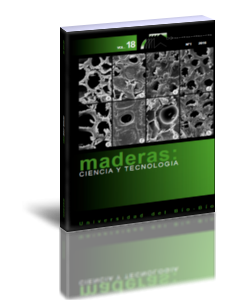Color changes of wood from Pinus taeda and Schizolobium parahybum treated by in situ polymerization of methyl methacrylate using cross-linkers
Keywords:
CIEL*a*b*, free radical polymerization, heat catalyst, UV-Vis, wood-polymer composites.Abstract
The aim of this study was to evaluate the colorimetric properties of Pinus taeda and Schizolobium parahybum woods treated by in situ polymerization. The wood samples were impregnated in a vacuum/ pressure system and polymerized in an oven at 90°C for 10h, using benzoyl peroxide at 1,5wt% as the catalyst. The treatments were characterized using attenuated total reflectance infrared (ATRIR) spectroscopy and weight percentage gain (WPG). The color evaluation was performed using CIEL*a*b* concepts, specular gloss, and UV-Visible spectrophotometry. Treated woods showed increases in band intensity related to polymers (1730, 1460 and 1145 cm-1), and WPG ranged from39 to 164%, depending of the wood species and treatments. Lightness decreased, while the Chroma, gloss and the color coordinates increased. A darkening of the all treated samples was observed, and confirmed by the decrease in the reflectance intensity between 400 and 700 nm.
Downloads
Download data is not yet available.
Downloads
How to Cite
D. Mattos, B., L. Missio, A., H.G de Cademartori, P., A. Gatto, D., & L. E. Magalhães, W. (2016). Color changes of wood from Pinus taeda and Schizolobium parahybum treated by in situ polymerization of methyl methacrylate using cross-linkers. Maderas. Ciencia Y Tecnología, 18(1), 113–124. Retrieved from https://revistas.ubiobio.cl/index.php/MCT/article/view/2244
Issue
Section
Article

































